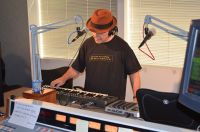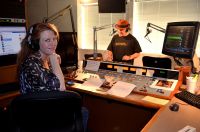 It happens. And when it does, “It’s kind of a pain…but worth it,” said Robbie Green, regional engineer for Cumulus, Texas, referring to the time Thomas Dolby stopped in at KHJK-FM 103.7 in Houston with his keyboard in tow.
It happens. And when it does, “It’s kind of a pain…but worth it,” said Robbie Green, regional engineer for Cumulus, Texas, referring to the time Thomas Dolby stopped in at KHJK-FM 103.7 in Houston with his keyboard in tow.
 For him, the painful part was figuring out how to interface Dolby’s keyboard and sampler into the studio for a live performance. Which he did using a DI box and by bringing the synths up on the station’s Wheatstone console so he could trim levels and adjust EQ for air.
For him, the painful part was figuring out how to interface Dolby’s keyboard and sampler into the studio for a live performance. Which he did using a DI box and by bringing the synths up on the station’s Wheatstone console so he could trim levels and adjust EQ for air.
This is just one of the many “live and local” scenarios that we expect to see more of in the coming months. A BIA/Kelsey report estimates radio accounted for 11.5% of the $132.7 billion total local ad-spending in 2013, with more to come our way due to radio’s local reach into the $75,000+ wage earners. It’s enough of a trend that many broadcasters are building full-scale, WheatNet-IP networked performance studios so that they can bring in live bands when the opportunity strikes.
You might be planning to build up your live and local presence, too, but may not have the budget for a new performance studio. It just so happens that we have a few audio engineers at Wheatstone who know their way around live mixing, so we asked them to give us some input on setting up live performers in the studio without having to build the next Madison Square Garden.
Where to plug in. This is the easy part. In most cases, you’ll be able to bring in the instrument and mic feeds to your digital console as you would any source. If you have a WheatNet-IP Intelligent Network, for example, you can route the vocal, guitar and keyboard feeds into a network BLADE (similar to a network node but with more features) and then bring them up on the console fader for dynamic mixing and EQ. But, a word of advice from Scott, our systems engineer who has put together live-to-air setups for public radio and mixes live sound for the local theatre companies in his spare time: When the gig is over, be sure to mute or pull down the fader before the guitarist unplugs!
By the way, if you don’t have processing and EQ built into your console, you still have options. You probably have a mic processor or two located somewhere in the studio -- and if it’s a Wheatstone M1 or M2 or M4-IP, that’s even better, because all our mic processors have that stuff built in. A lot of Wheatstone and Audioarts consoles have EQ and dynamics processing already on-board.
How to plug in. XLR vs. 1/4", balanced vs. unbalanced? Standard studio mics almost always have XLR connectors, which means you’ll also find XLRs on the receiving end of studio consoles and their network units as well. Our WheatNet-IP network BLADEs for feeding our digital IP consoles come with a variety of input options; our microphone processors and BLADEs have XLR inputs; other BLADEs have combinations of XLR, RJ-45, and "D" connector inputs and outputs.
But here’s the thing you need to know. Whereas most professional consoles and their network boxes are balanced in, electric guitars and keyboards are generally unbalanced ¼” jacks out. If you plan to connect these into the console, you will probably need a DI (Direct Injection) box to give you a ground-isolated balanced signal to feed to the console input (or network I/O, which in Wheatstone’s case is the BLADE). “Yes, you can in some cases wire an unbalanced device directly to a balanced input, but doing so, particularly in the high RF environment of a radio station, is asking for ground loop problems,” said Scott.
How to stay level. Guitars and keyboards usually output to instrument level at about –20 dBV or so, which is between microphone and line level. Consumer gear with unbalanced ¼” TS or RCA jacks output to -10 dBV line level whereas pro gear with ¼” TRS connectors expects a +4 dBu line level. Most level adjustments can be done using the console’s trim control, with the exception of mic levels, which are usually around 50 or 60 dB less than line level and will often need some sort of pre-amplification to bring them to a usable level for a line level input.
IP audio as a snake. If you can’t fit a five-piece band into your production or on-air studio – and who can these days? – it's no big deal. Bob Martin, who does our marketing material and is a guitarist of some fame with a few albums to his credit, suggests that your IP network can function as an audio snake between the on-air and/or production studios and a designated or makeshift performance studio. He’s seen something similar as a guest guitarist for pubcaster WXXI-FM/TV in Rochester, New York, a while back: a Wheatstone network pushed audio around to various surfaces in their studios. This allowed for separate TV and Radio mixes as well as the ability to capture a multitrack recording that could be saved for future mixing projects (such as the CD and DVD release). All this was done without the need for a conventional audio snake with transformer splits for the various feeds, although the engineers used smaller snakes to carry the mic and direct feeds from the stage area to the network I/O. (Check out this video of Bob strumming in the studio.)
In the case of our WheatNet-IP system, for example, all you need is a network BLADE at each end, which will give you eight stereo channels (16 mono) running from room to room. You can bring in the stereo or surround feed from the band’s audio mixer all on one fader, or bring in each instrument for mixing on your console. Our microphone BLADE, for example, has all the XLR and jack inputs you might need for vocals, guitars and keyboard on the one end, and our digital BLADE for the on-air or production studio down the hall simply picks up the sends from the mic BLADE and assigns them to channels on the Wheatstone IP console for mixing.
.. a very big snake. If you go the audio IP snake route, you’ll want to pay attention to your system’s effective throughput. Some IP audio systems have full Gigabit Ethernet between studios, but only 100 megabits/second up to the console. That’s going to create a bottleneck if you run too many channels down the line, which will result in audio delay, for example. In the case of WheatNet-IP, however, the system is designed to run at an overall Gigabit Ethernet throughput so it has the capacity to carry a whole lot of audio channels across that one link and to the console without QoS issues or discernable delay. Said Scott, “At the ‘rule of thumb’ bandwidth of five megabits per second per stereo stream, taking network overhead and other factors into consideration, a 100 megabit link gets congested very quickly with even a dozen or so signals in each direction. Gigabit Ethernet removes that bottleneck for us.”
It’s possible to have a full ensemble playing on one end of the WheatNet-IP snake, and for a remote IP console to pick up all those feeds at the same time for real-time mixing on the other end. You can fit a lot of audio channels in that 1 gig/second pipe – we know, we’ve done it. In fact, our BLADEs happen to have two 8-channel utility mixers for mixing, summing and controlling audio, so it’s feasible to virtually mix a live concert straight off the network.

